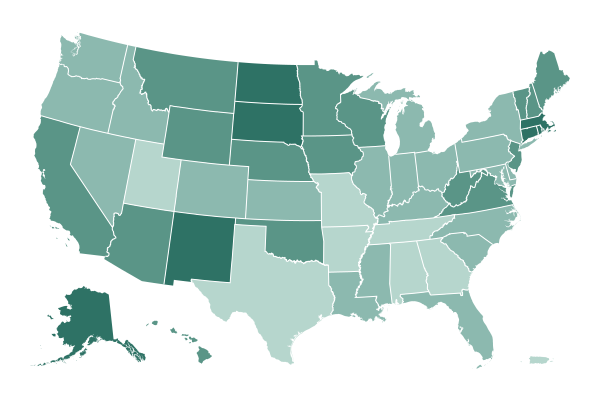The average number of vaccine doses being administered across the United States per day topped two million for the first time on Wednesday, according to data from the Centers for Disease Control and Prevention. A month ago, the average was about 1.3 million.
President Biden set a goal for the country shortly after taking office to administer more than 1.5 million doses a day, which the nation has now comfortably exceeded.
Mr. Biden has also promised to administer 100 million vaccines by his 100th day in office, which is April 30. As of Thursday, 54 million people have received at least one dose of a Covid-19 vaccine. Johnson & Johnson’s one-shot vaccine was authorized for emergency use on Saturday, but those doses do not appear yet in the C.D.C. data.
The milestone was yet another sign of momentum in the nation’s effort to vaccinate every willing adult, even as state and city governments face several challenges, from current supply to logistics to hesitancy, of getting all of those doses into people’s arms.
Mass vaccination sites across the country are opening up or increasing their capacity, in part to respond to the new influx of doses from Johnson & Johnson. In New York, Gov. Andrew M. Cuomo announced on Thursday that three short-term mass vaccination sites will open in the state on Friday. Three other state-run sites, including one at Yankee Stadium, will begin administering shots around the clock. In Georgia, Gov. Brian Kemp announced five new sites will open on March 17.
The Federal Emergency Management Agency has recently helped open seven mega-sites in California, New York and Texas, that are staffed with active-duty troops. In Chicago, a vaccination site at the United Center will open next week, with a capacity of 6,000 shots a day. Many more such sites are planned.
There have been some hiccups in the massive logistical challenge of distributing millions of doses across the country, with special requirements for storage and handling. In Texas, more than 2,000 doses went to waste over the past two weeks, according to an analysis by The Houston Chronicle. A majority of those losses were blamed on blackouts that swept the state in February, leaving millions of homes and businesses without power, some for multiple days.
And Mr. Biden has made equity a major focus of his pandemic response, saying he wants pharmacies, mobile vaccination units and community clinics that help underserved communities to help increase the pace of vaccinations. Experts say that Black and Latino Americans are being vaccinated at lower rates because they face obstacles like language barriers and inadequate access to digital technology, medical facilities and transportation. But mistrust in government officials and doctors also plays a role and is fed by misinformation that is spread on social media. In cities across the country, wealthy white residents are lining up to be vaccinated in low-income Latino and Black communities.
The president said on Tuesday that the country would have enough doses available for every American adult by the end of May, though he said it would take longer to inoculate everyone and he urged people to remain vigilant by wearing masks.
The administration also announced it had brokered a deal in which the drug giant Merck & Co. will help manufacture the new Johnson & Johnson vaccine. The unusual agreement between two rivals in the pharmaceutical industry was “historic,” Mr. Biden said on Tuesday. “This is a type of collaboration between companies we saw in World War II.”
Mr. Biden was also going to invoke the Defense Production Act, a Korean War-era law, to give Johnson & Johnson access to supplies for manufacturing and packaging vaccines.

If Gov. Greg Abbott of Texas, a Republican, thought he would be universally embraced at home after he suddenly announced that he was lifting a statewide mask requirement and allowing all businesses to operate at full capacity, he was quickly proved wrong.
“I don’t know what they’re thinking,” said Ernestine Cain, 52, a home health aide who was picking up a case of bottled water at a distribution site in San Antonio on Wednesday morning. “You still need to give it time. You can’t just cut it like that.”
Texas has been hit especially hard by the coronavirus pandemic, recording more than 44,000 deaths and nearly 2.7 million cases.
Sylvester Turner, the mayor of Houston, called the governor’s decision “dangerous.” Mayor Ron Nirenberg of San Antonio said it was a “huge mistake.” And Dr. Victor Treviño, the health authority of Laredo, said he feared that the move would “eliminate all the gains that we have achieved.”
Some, of course, were overjoyed.
“I’m proud to be Texan,” said Amber Rodriguez, 32, who owns an air-conditioning company in Houston and declared that “this is the first step to bring Texas back.”
Kendall Czech, 26, a leasing agent who moved to Dallas last summer from California in part because of that state’s strict Covid-19 restrictions, said, “I think that the governor just gained some guts.”
The reviews were less positive on Pennsylvania Avenue in Washington, D.C., where President Biden had harsh words for both Texas and Mississippi, whose governor also announced on Wednesday that he was lifting the statewide mask mandate and rescinding capacity limits on businesses.
Mr. Biden said that it was critical for officials to follow the guidance of public health experts as the vaccination campaign gains momentum.
“The last thing we need is Neanderthal thinking that in the meantime, everything’s fine, take off your mask and forget it,” the president told reporters at the White House. He and his top health advisers have emphasized the benefit of wearing masks, which help prevent the spread of the virus. Last year, mask wearing became a divisive flash point, with many Republican-led states reluctant to issue a broad mandate.
On Thursday, Gov. Kay Ivey of Alabama, a Republican, extended her state’s mask mandate for another month. Striking a different tone than those of her peers in Mississippi and Texas, she said she wanted to keep what she called an effective policy to require masks for just a bit longer.
In Mississippi, Gov. Tate Reeves, a Republican , was unrepentant.
“Mississippians don’t need handlers,” he said. “As numbers drop, they can assess their choices and listen to experts. I guess I just think we should trust Americans, not insult them.”
Mr. Reeves did, however, encourage his citizens to “do the right thing” and wear a mask.
So did the governor of Texas, where vaccinations considerably trail the national average, more than 7,000 new cases are being reported a day and, in recent weeks, ominous variants of the virus have appeared.
The decision to lift the restrictions was framed as long-awaited relief after an exhausting stretch of isolation and hardship. But many saw it as an attempt to distract Texans from the widespread infrastructure failures that left many without power and water after a brutal winter storm.
“It’s pretty obvious ,” said Kaitlyn Urenda-Culpepper, an El Pasoan now living in Dallas, echoing a commonly heard sentiment across the state.
In a statement on Tuesday, Mr. Abbott defended his decision.
“We must now do more to restore livelihoods and normalcy for Texans by opening Texas 100 percent,” he said. “Make no mistake, Covid-19 has not disappeared, but it is clear from the recoveries, vaccinations, reduced hospitalizations and safe practices that Texans are using that state mandates are no longer needed.”
Ms. Urenda-Culpepper, whose mother died from Covid-19 in July, said there was no choice now but to hope that the governor had made a wise decision.
“I don’t want him to be wrong,” she said. “But obviously for the greater good of the people, I’m like, ‘Man, you better be right and not cost us tens of thousands more people.’”
transcript
transcript
Alabama Governor Extends Statewide Mask Order Until April
Gov. Kay Ivey of Alabama on Thursday said she would keep a statewide mask order in place until April 9, breaking with Republican governors who planned to end mask mandates against the advice of health officials.
-
We need to get past Easter, and hopefully allow more Alabamians to get their first shot before we take a step that some of the states have taken to remove the mask order altogether and lift other restrictions. Folks, we’re not there yet, but goodness knows we’re getting closer. Our new modified order will include several changes that will ease up some of our current restrictions while keeping our mask order in place for another five weeks through April 9. But let me be abundantly clear, after April the 9th, I will not keep the mask order in effect. Now, there’s no question that wearing masks has been one of our greatest tools in combating the spread of the virus. That, along with practicing good hygiene and social distancing, has helped us keep more people from getting sick or worse, dying. And when we — even when we lift the mask order, I will continue to wear my mask while I’m around others and strongly urge my fellow citizens to use common sense and do the same thing. But at the — but at that time, it will become a matter of personal responsibility and not a government mandate.
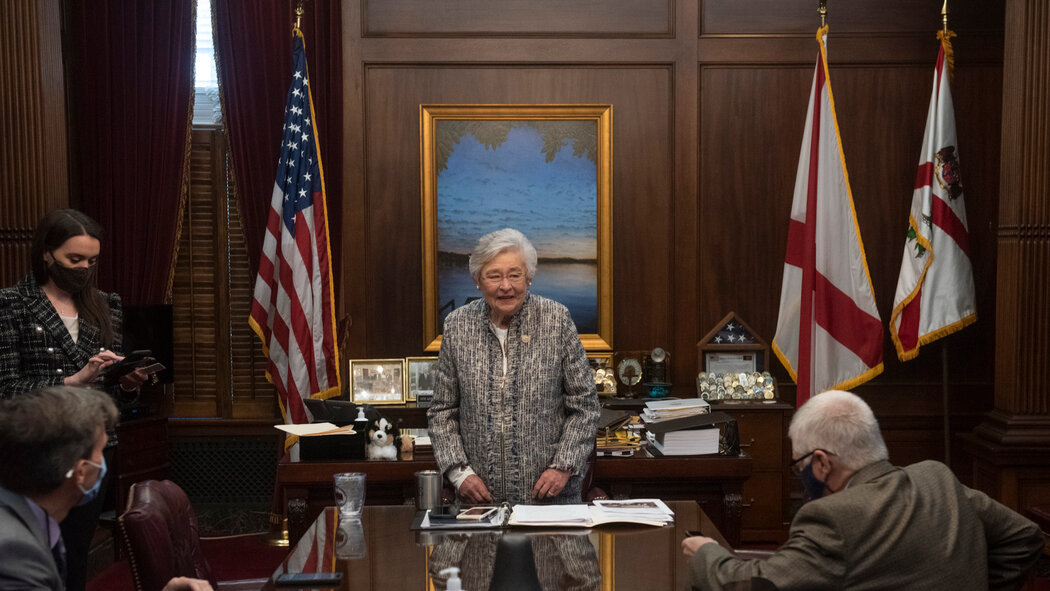
Gov. Kay Ivey of Alabama on Thursday said she was extending the statewide mask order for another month, breaking with two other Republican governors who have announced plans to lift mandates in their states against the advice of federal health officials.
Aside from her decision on the mask mandate, which will now be in place until April 9, Ms. Ivey said other virus related restrictions, including allowing restaurants and breweries to operate at full capacity, will also be lifted then.
“There’s no question that wearing masks has been one of my greatest tools in combating the virus,” she said at a news conference.
New coronavirus cases, hospitalizations and deaths are down in the state, according to a New York Times database. About 14 percent of the residents in the state have received at least one dose of the vaccine. The state’s health officer, Dr. Scott Harris, said the state had already given more than a million vaccine shots.
“We need to get past Easter and hopefully allow more Alabamians to get their first shot before we take a step some other states have taken to remove the mask order altogether and lift some other restrictions,” Ms. Ivey said on Thursday. “Folks we’re not there yet, but goodness knows we’re getting closer.”
In recent days, the director of the Centers for Disease Control and Prevention, Dr. Rochelle Walensky, has been pleading with state officials not to relax health precautions now, warning about the trajectory of cases nationwide and the detection of more cases of virus variants across the country.
“We are just on the verge of capitalizing on the culmination of a historic scientific success: the ability to vaccinate the country in just a matter of three or four more months,” Dr. Walensky said on Wednesday. “How this plays out is up to us. The next three months are pivotal.”
And President Biden on Wednesday criticized officials in several states, including Texas and Mississippi, for lifting mask mandates, describing their actions as “Neanderthal thinking” and insisting that it was a “big mistake” for people to stop wearing masks.
Ms. Ivey issued a statewide mask order last summer when the number of cases in the state soared less than three months after she eased restrictions at the end of April. The mask mandate has drawn criticism from members of her own party. She extended it in January when the state was seeing a second surge of cases.
On Thursday, she said she planned to wear her mask around others, even after the statewide over was lifted. She urged residents to “use common sense and do the same thing.”
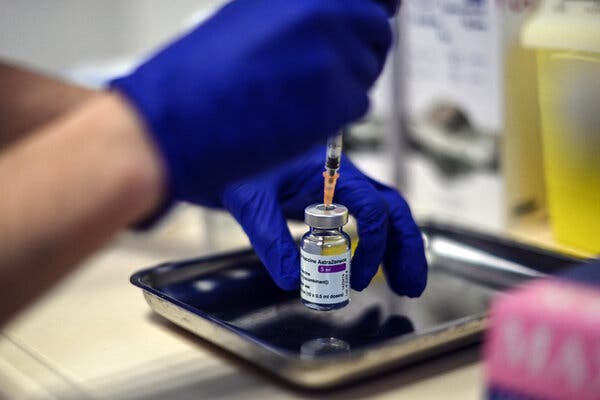
Italy blocked a shipment of the Oxford-AstraZeneca vaccine from being flown to Australia on Thursday, making good on the European Union’s recent threats to clamp down on exports of the shots and ratcheting up a global tug of war over vaccine supplies.
It was the first time that a member country used new E.U. regulations to keep vaccine from being exported. The shipment consisted of more than 250,000 doses.
Italy’s foreign ministry said that Italy acted because Australia is regarded as a “nonvulnerable” country under the new regulations; because vaccines are in short supply in Italy and the European Union generally; and because of delays in AstraZeneca’s vaccine deliveries to the bloc’s member countries.
The new regulations empower the E.U.’s members to keep any vaccine doses made within the bloc from being sent abroad if the manufacturer has not yet met its supply obligations to member countries. Pfizer and AstraZeneca are the two companies currently manufacturing vaccines within the bloc.
So far, the European Commission has approved 174 requests for export authorizations.
Australia has had fewer coronavirus cases, relative to its size, than almost any other large developed country, and has been recently averaging only nine new cases a day, according to a New York Times database. Italy, with less than three times the population of Australia, is averaging more than 18,000 new cases a day.
AstraZeneca applied on Feb. 24 for an authorization for the Australia shipment. Two days later, Italy told the European Commission it intended to deny the application, the foreign ministry said in statement Thursday night. After the commission offered no objection, the ministry said it notified AstraZeneca of the denial on Tuesday.
For earlier shipments, “Italy gave its authorization because they were small quantities aimed at activities of scientific research,” the foreign ministry said. “However, this time it was 250,700 doses.”
AstraZeneca declined to comment.
The company infuriated E.U. officials in January when it said it would significantly cut its planned February and March deliveries to member nations. They accused the company of sending doses to Britain that had been promised to the European Union, in breach of contractual obligations.
Valdis Dombrovskis, a top commission official, said in announcing the new export control regulations that the situation had “left us with no choice other than to act.”
The commission has maintained that the controls are about transparency, not vaccine nationalism. But with Europe’s sluggish vaccination campaigns lagging behind those of other developed nations and the bloc growing desperate for doses, member countries have signaled a willingness to use the rules for their own benefit.
Prime Minister Mario Draghi of Italy pressed fellow European leaders in a meeting last week to use all tools at hand to hold pharmaceutical companies accountable for delays in delivering doses.
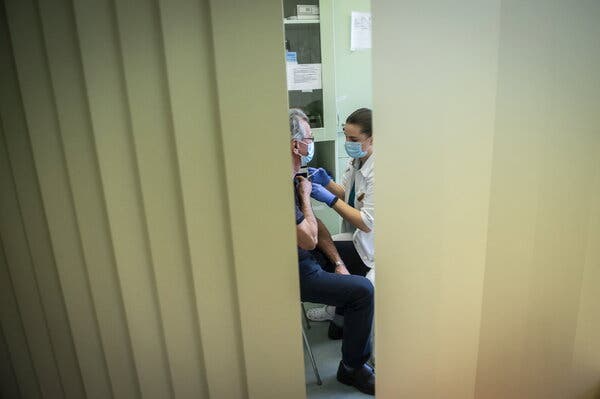
The European Union drug regulator announced on Thursday that it was beginning a rolling review of the Russian-developed Sputnik V vaccine, after one of the bloc’s members moved unilaterally to use the shots and another is about to do the same.
The announcement by the regulator, the European Medicines Agency, comes amid a slow and frustrating vaccine rollout in the European Union that has been dogged by supply disappointments as well as major logistical problems.
The review is the formal process the agency uses, in which scientists examine data on the shots’ efficacy and side effects — it is the fastest way to examine the vaccine as a whole, with a view to eventually granting it authorization for use in the European Union.
The agency said in a news statement that the Gamaleya Research Institute, which developed the vaccine, had applied for the rolling review through a Germany-based entity named R-Pharm Germany.
Hungary broke with the bloc and ordered its own share of Sputnik V vaccines this year, granting the shots authorization locally through its national regulator. As the supply woes in the European Union began to bite, the Czech Republic this month announced it would follow suit. A deal to acquire the Russian vaccine has also set off a political crisis in Slovakia.
Several other European governments were considering a similar move, despite the fact that Ursula von der Leyen, president of the European Commission, the bloc’s executive arm, recently cast doubt on the Sputnik V vaccine.
“We still wonder why Russia is offering theoretically millions of millions of doses while not sufficiently progressing in vaccinating their own people,” Ms. von der Leyen said during a news conference last month.
“This is also a question I think that should be answered,” she added. “They have to submit the whole set of data, indeed go through the whole scrutiny process like any other vaccine.”
While the announcement of the review is an important step in the formal scientific scrutiny by the European regulator, there is no telling how long the process will take. The agency will require deep access to data underlying the vaccine’s performance, as well as site visits to its production facilities, before granting authorization.
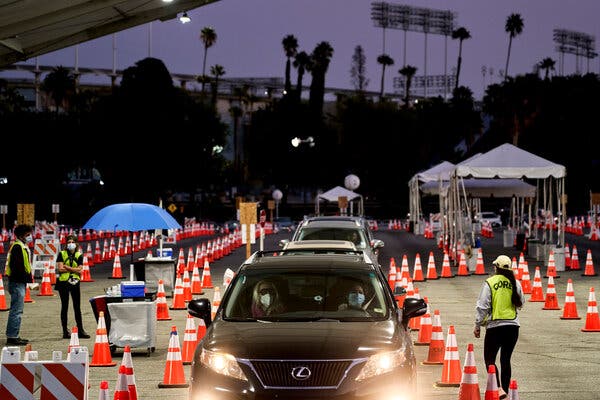
Hoping to hasten its emergence from the coronavirus pandemic, California will begin channeling 40 percent of new vaccine doses to low-income communities pummeled by the coronavirus, officials in Gov. Gavin Newsom’s administration said late on Wednesday.
The strategy is an effort to make the vaccine rollout more equitable and to reduce the number of counties considered most at risk, as well as to speed California’s ability to reopen, officials said.
Once 400,000 more doses are administered in the target communities, the state will ease restrictions in high-risk counties, officials said, a threshold that could be reached in about two weeks.
The targeted communities are defined using a composite “health equity” index that assesses need based on income, education, transportation and housing availability. State data has indicated that when vaccination efforts are targeted at poorer Californians, wealthier people have gamed the system. Black and Latino residents have been inoculated in smaller numbers than their white neighbors.
California faced a surge in infections in December and January, but cases have fallen 40 percent statewide — to late October levels — in the past two weeks, intensifying calls for the state government to relax restrictions.
Mr. Newsom, whose handling of the pandemic has helped fuel a Republican-led recall campaign against him, has crisscrossed the state, opening vaccination centers and assuring people that immunization is the “light at the end of the tunnel.” But he has also made clear that the virus and its variants remain lethal: At least 287 new coronavirus deaths and 4,316 new cases were reported in California on March 2.
When the governor of Texas announced this week that the state would lift its mask mandate, Mr. Newsom tweeted that the move was “absolutely reckless.”
Administration officials said California would keep in place its mask mandate. The vaccine blitz, they said, was aimed at quashing the further spread of Covid-19 so people could go back to work and businesses could reopen safely.
About 1.6 million vaccine doses have so far been delivered in low-income communities.
Once two million vaccines have been administered in those locations, officials said, the state will adjust its color-coded tier system to make it easier for counties to move into less restrictive categories, which will hasten the reopening of schools. When there are four million doses in the targeted areas, additional tiers will be adjusted to further ease reopenings.

A surge in coronavirus cases has prompted Iraqi officials to impose lockdowns. Shia authorities have suspended religious pilgrimages. And on Sunday, the Vatican’s ambassador contracted the virus and went into isolation.
For good measure, suicide bombings, rocket attacks and geopolitical tensions have increased, too.
But Pope Francis — to the bewilderment of many — is intent on going anyway.
After more than a year cooped up behind the Vatican walls, Francis is to fly to Baghdad on Friday at one of the most virulent moments of the entire pandemic, sending a message that flies in the face of nearly all public health guidelines.
“The day after tomorrow, God willing, I will go to Iraq for a three-day pilgrimage,” the pope said on Wednesday in his weekly address. “I ask that you accompany this apostolic trip with prayer so that it can occur in the best way possible, bear the hoped-for fruit. The Iraqi people await us.”
Francis was vaccinated in mid-January, and has called on wealthy countries to give vaccines to poorer ones, calling a refusal to vaccinate “suicidal.”
The pope’s entourage is also vaccinated, but there is anxiety among his supporters that a trip intended largely to bring encouragement to Iraq’s long-suffering Christians has the potential to be a superspreader event. The possibility of the 84-year-old pope’s inadvertently endangering an Iraqi population with practically no access to vaccines is not lost on his allies back in Rome.
“There is this concern that the pope’s visit not put the people’s health at risk, this is evident,” said Antonio Spadaro, a Jesuit priest and close ally of Francis. “There is an awareness of the problem.”
The Vatican insists the trip will be a safe, socially distanced and sober visit devoid of the usual fanfare and celebrations. And a Vatican spokesman played down the number of cases in Iraq when reporters asked how the pope could possibly justify not delaying a trip that could endanger so many.
Andrea Vicini, a medical doctor, Jesuit priest and professor of moral theology and bioethics at Boston College, said he admired the pope’s willingness to put his own skin in the game for peace when it came to promoting dialogue with Islam and protecting the persecuted and people at the margins.
“He wants to show that he is ready to risk,” Father Vicini said. “The problem is that others will be at risk.”
GLOBAL ROUNDUP
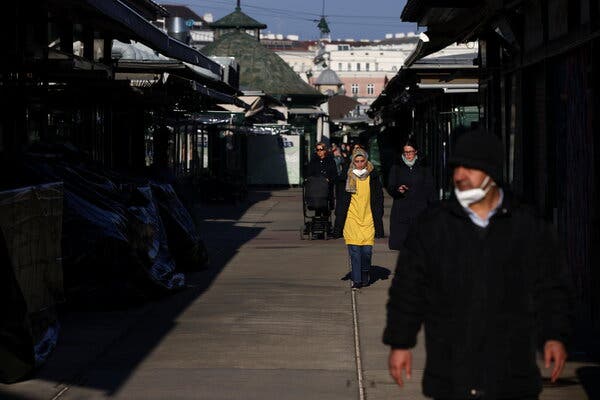
Austrian officials will carry out a mass vaccination drive in the western district of Schwaz in the hopes of stabilizing the alpine area, which has been battered by a surge in new coronavirus infections driven in part by the variant B.1.351, first identified in South Africa.
The pilot program in Austria is the first such inoculation drive in the European Union. Like most of the rest of the bloc, the country is lagging behind some other wealthy nations — such as Britain, Israel and the United States — in its vaccine rollout. Only 5 percent of residents in the alpine state of Tyrol, which includes Schwaz, have received at least one shot.
All residents above the age of 16 will be able to get free vaccinations when the drive begins next week. The European Union has allocated 100,000 extra doses of the Pfizer-BioNTech vaccine for the area near the western Austrian city of Innsbruck, which is home to about 86,000 people.
Chancellor Sebastian Kurz said on Wednesday that the effort would be “our chance to eradicate the variant in the region of Schwaz.”
The infection rate in the broader Tyrol region has declined from its peak of about 800 per 100,000 people over a seven-day period in November to just over 100 per 100,000 in the past week. But the German government closed its side of the border with the area on Wednesday night when it became clear that a high percentage of those infections were caused by the B.1.351 variant.
On Thursday, Mr. Kurz traveled to Israel where, together with Prime Minister Mette Frederiksen of Denmark, he planned to speak with experts about collaborating on future vaccines.
In other news from around the world:
-
Sinopharm of China, a state-owned company that is manufacturing two vaccines in the country, can make a maximum of three billion doses this year, its chairman told state news media on Wednesday. The number represents a tripling of the company’s previous target.
-
The state of São Paulo, Brazil, will head into its toughest restrictions yet this weekend, Gov. João Doria told reporters on Wednesday, as cases surge in the region, home to the country’s second-biggest city. All bars, restaurants and nonessential stores will close until at least March 19, according to The Associated Press. The restrictions come as the country grapples with a concerning new variant that has lashed the Amazonian city of Manaus, in the northwest, and is spreading to other places. Brazil recorded its highest single-day toll of the pandemic this week.
-
Germany’s independent vaccine panel has said that the Oxford-AstraZeneca vaccine can be used on people 65 and over, reversing earlier guidance. Although the European drug regulator authorized use of the shots in January, the German panel had initially refused to recommend the vaccine because it had not been tested enough in that age group. Because Germany is still focusing its vaccination drive on those over 80, much of the AstraZeneca doses had lingered in storage.
-
Hungary announced on Thursday that it would introduce a new round of restrictions next week, with some schools closed and nonessential stores shuttered, to combat a sharp rise in coronavirus cases. The announcement comes as a blow to Prime Minister Viktor Orban, who had been vocal about his hopes for the country to begin reopening this month.
Albee Zhang contributed research.

Derek Furtado, a sophomore at Norwich University, had just stepped out of the shower in his dormitory and was shaving, a towel wrapped around his waist, when he looked to his left and saw the figure of a man in military uniform.
“That was when my heart sunk,” recalled Mr. Furtado, a cadet who plans to commission into the Coast Guard. He pulled himself together, stood at attention and said, “Good morning, sir!” The circumstances were not ideal. “He has two stars on his chest,” Mr. Furtado said. “I’m in a towel.”
But he would have to get used to it, because, it turned out, Col. Mark C. Anarumo, the university’s president, was his new hall mate.
Among the surprising outcomes of the coronavirus pandemic was that Dr. Anarumo, newly arrived as president of the private military college in Vermont, decided that the best way to support students who were quarantining in their rooms was to move into the dorm with them.
He had ordered the quarantine, a decision he made with a feeling “between caution and dread,” he said. He knew — because he had lived through it — that isolating students in their rooms put them in another kind of danger.
“So that’s when I decided, I’ve got to move into the dorm,” he said. Dr. Anarumo, 50, who retired from the Air Force in 2020 and has a doctorate in criminal justice, said that he wanted to be treated like any other resident.
The risks of in-room isolation had become clear last spring, when Dr. Anarumo was still teaching at the Air Force Academy in Colorado. Younger cadets had gone home, but nearly 1,000 seniors were isolating on campus for two months until graduation.
Conditions were strict: They were in single rooms, eating takeout and studying remotely. Dr. Anarumo was preparing to leave for his new job, when he learned that there had been a suicide in the dorm. Two days later, there was another.
As some parents lashed out, the administration relaxed the measures, allowing seniors to double up in rooms and leave campus for meals. The Academy’s leaders revisited their earlier decisions, reconsidering the risks of isolation, said Dr. Anarumo, who has a Ph.D. in criminal justice.
“There’s a phrase the military call ‘going inside’; it means getting inside your own head,” he said. “Sometimes, when you’re in isolation, you go inside and you kind of get lost in your own thoughts, without the forced interaction.”
Dr. Anarumo had been through this before; over three decades in the Army and Air Force, he had lost 11 men and women to suicide.
By the time he arrived at Norwich, Dr. Anarumo felt strongly that the benefits of quarantine needed to be weighed carefully against its toll on mental health.
“I am concerned enough about the mental health on campus that I believe we may have a suicide if we do not break the pressure and let people leave, and incentivize their departure,” he told the university’s board.
Mental health researchers are just beginning to gather data on the estimated 26 million college students whose lives have been disrupted by the virus.
“We’re enforcing physical loneliness,” said Dr. Rachel C. Conrad, the director of Young Adult Mental Health at Brigham and Women’s Hospital in Boston. “There’s not really anything to compare it to, exactly, from our history.”
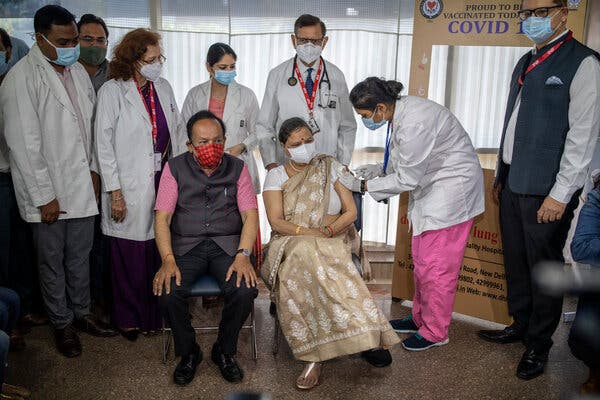
India’s ambitious but troubled campaign to inoculate its vast population against Covid-19 — and, in the process, to burnish its reputation as a manufacturer and innovator — received a major lift after initial trial results showed a homegrown vaccine was safe and effective.
Bharat Biotech, the Indian drug company that developed the shots, said late Wednesday that early findings from clinical trials involving nearly 26,000 subjects showed that the vaccine, Covaxin, had an initial efficacy rate of 81 percent.
The results have yet to be peer reviewed, the company said, and it was unclear how effective Covaxin would prove to be in a final analysis.
Still, the results were met with relief in India. Covaxin was approved by government officials in January and administered to millions of people even though it had not yet been publicly proved. Many in the country, including frontline health care workers, had feared that Covaxin could be ineffective or worse, slowing down the national campaign to inoculate 1.3 billion people.
Officials in Brazil, where the government had bought doses of Covaxin, had recently questioned whether the vaccine worked.
The results this week could alleviate some of those concerns, said Dr. Anant Bhan, a health researcher at Melaka Manipal Medical College in southern India. Still, he said, questions will linger over Covaxin until the research is completed.
“This data will now need to be examined by the regulator in India and could then have an impact on the regulatory decisions with regards to the vaccine,” Dr. Bhan said.
If the results hold, they could also benefit Prime Minister Narendra Modi of India, who has stressed his intention of making India self-reliant. An effective, Indian-developed vaccine could add credibility to that campaign.
India approved Covaxin for emergency use in early January along with the Oxford-AstraZeneca vaccine, which is known in India as Covishield. When the vaccination drive started less than two weeks later, most people were not allowed to choose which shot they got.
The move to authorize Covaxin’s use came under sharp criticism from pharmaceutical bodies and health experts, who questioned the scientific logic behind approving a vaccine that was still in trials. Indian officials often denounced those doubts without explaining the rush. Instead, they portrayed the endorsement of Covaxin through a lens of nationalism, saying that it showed India’s emergence as a scientific power.

As the pandemic gripped New York City, it propelled an enormous surge in online shopping. Amazon, the giant online retailer, went shopping too.
Amazon has spent the pandemic embarking on a warehouse shopping spree in New York, significantly expanding its footprint.
It has snatched up at least nine new warehouses in the city, including a behemoth rising in Queens that, at one million-plus square feet, will be its largest in New York, and today has at least 12 warehouses in the five boroughs. And it has added more than two dozen warehouses in suburbs surrounding the city.
No other large competitor has a single warehouse in the city and Amazon has largely left most of its chief rivals, like Walmart and Target, behind.
“Amazon had people making deals,” said Adam Gordon, whose real estate firm Wildflower owns several warehouses in the city. “And they were outcompeting.”
New York City is the biggest and most lucrative market in the United States. That helps explain the expansion by the company just two years after it abruptly scuttled plans to build a gleaming new headquarters in Long Island City, Queens.
New York has about 128 million square feet of industrial space, far less than many smaller cities (not to mention narrow streets and a brutal lack of parking).
Many packages come to New York from New Jersey and Pennsylvania, where there is room to build bigger and cheaper warehouses. And in the past year, Amazon has added 14 new warehouses in New Jersey and on Long Island, totaling more than seven million square feet.
But having warehouses in the city is more cost effective and can trim roughly 20 percent off delivery expenses compared with deliveries that originate in New Jersey. Amazon, which owns Whole Foods, has also used the grocery stores to fulfill online orders, with its workers often outnumbering store customers.
Roughly 2.4 million packages are delivered in New York City every day, nearly half a million more than before the pandemic, and city data shows that 80 percent of deliveries are to residential customers, compared with 40 percent before the outbreak.
“We are excited to continue to invest in the state of New York by adding new delivery stations,” said Deborah Bass, an Amazon spokeswoman, adding that the company’s goal was to “become part of the fabric of New York City by embracing the people, the needs, and the spirit of the community.”
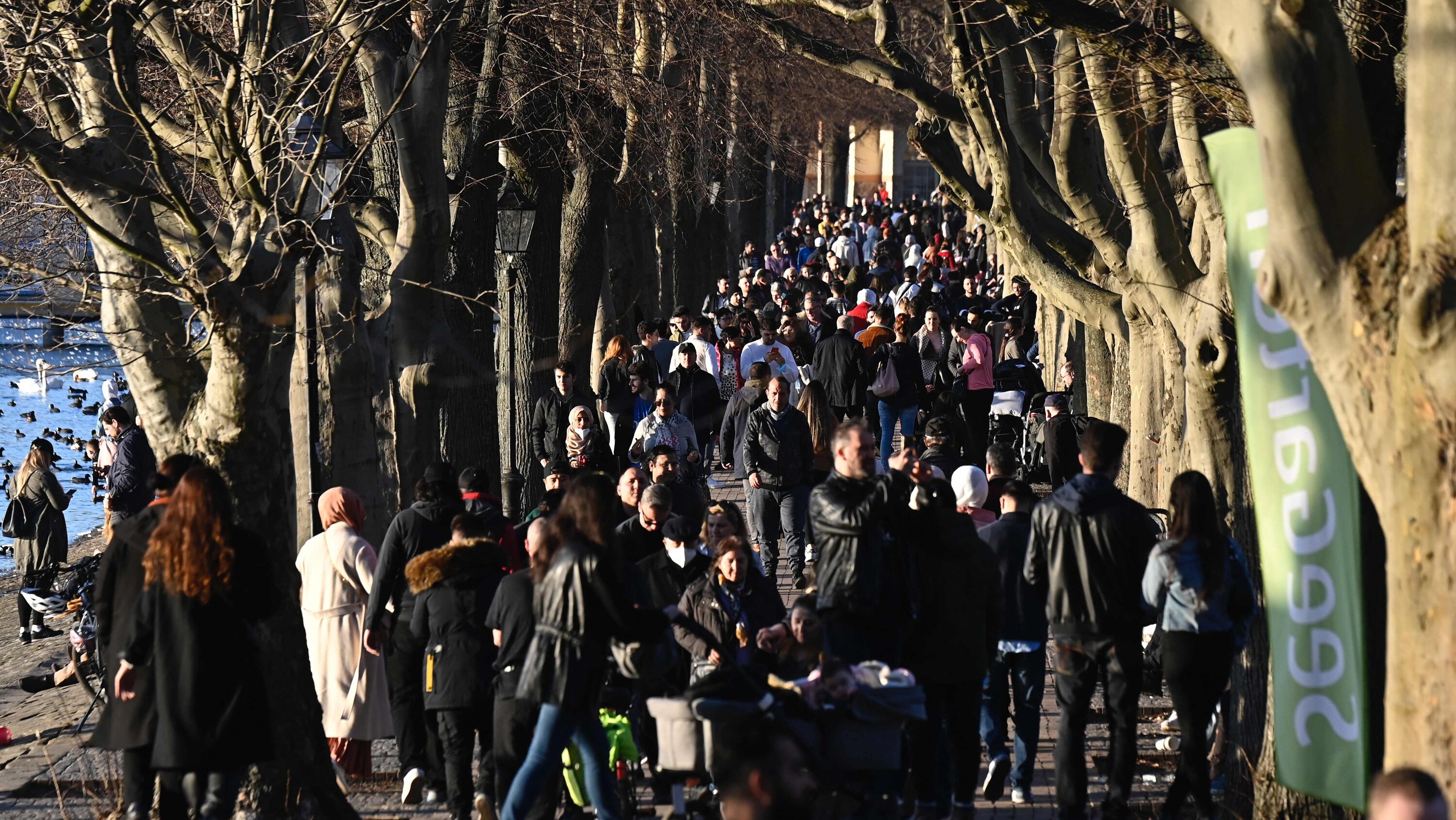
Central and Eastern Europe is experiencing a resurgence in coronavirus infections partly driven by new variants but also by the relaxing of restrictions, the World Health Organization’s top official in Europe said on Thursday.
After six successive weeks of declining infection numbers across Europe, the continent experienced a 9 percent rise in coronavirus cases in the past week, Hans Kluge, the W.H.O.’s regional director told reporters. More than half of the 53 countries in the European region had recorded an increase in infections, he said, including some in Western Europe.
“Over a year into the pandemic, our health systems should not be in this situation,” Mr. Kluge said. “We need to get back to basics.”
The increase came as 43 European countries reported cases of the B.1.1.7 variant first identified in Britain, which has much higher transmissability, he said, adding that 26 countries had found cases of the B.1.351 variant first discovered in South Africa and that 15 had reported cases of the P.1 variant first discovered in Brazil.
The B.1.1.7 variant already accounts for more than half of the new cases of infection in several countries, including Britain and Denmark, and is expected to soon pass that level in Germany.
But W.H.O. officials stressed that new variants were only part of the problem, calling for a gradual lifting of restrictions and travel bans when there was evidence to support it and for an accelerated rollout of shots.
Vaccinations have started in 45 European countries, Mr. Kluge said, but only around a quarter of health workers in 20 European countries have completed vaccination against Covid-19.
Frustration at the slow introduction of vaccines in Europe has driven several governments to bypass the European Union’s purchase program in favor of bilateral supply deals, but the W.H.O. underscored that countries could not rely solely on vaccines to curb infections.
Catherine Smallwood, health emergencies expert for the W.H.O. in Europe, said, “We are not going to take the heat out of transmission immediately” through inoculations. “It’s going to take a long time,” she noted, “so we will have to be patient and we need to use all of the other measures we have at our disposal.”
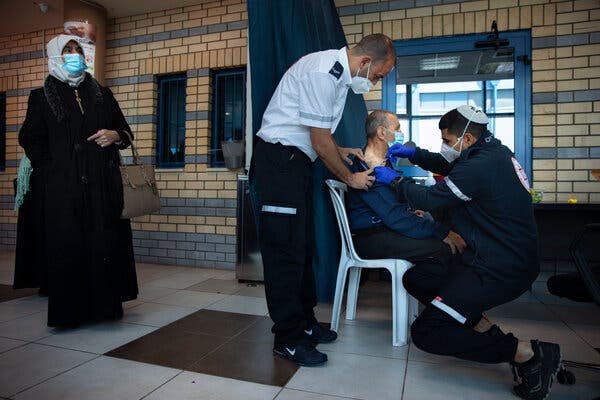
Most Palestinians living in the occupied territories have yet to be vaccinated against the coronavirus, setting off a rancorous debate about whether Israel has a duty to vaccinate Palestinians living under Israeli occupation.
But among Palestinians in the occupied West Bank, questions are now being asked of their own leadership, which has been accused of siphoning some of the few doses allocated for Palestinians and distributing them to the senior ranks of the governing party, allies in the news media and even to family members of top dignitaries.
Like many governments worldwide, the Palestinian Authority, which exercises limited control over parts of the occupied territories, has officially prioritized its senior administrative leadership and frontline health workers, as well as people who come into regular contact with the authority’s president and prime minister.
But in secret, the authority has diverted some of the thousands of vaccines it has received to some senior members of the ruling party in the West Bank who have no formal role in government, according to two senior Palestinian officials and a senior official from the party, Fatah, who all spoke on condition of anonymity.
Vaccines have also been secretly given to top figures at major news outlets run by the authority, according to one of the senior Palestinian officials and two employees at those outlets. Family members of certain government officials and Fatah leaders were also given the vaccines, the senior official and a former government official said.
Already frustrated at their exclusion from Israel’s world-leading vaccination program, ordinary Palestinians now accuse their leaders of hoarding some of the relatively few vaccines that the authority has obtained, even amid a surge in infections and tightened restrictions.
“Of course it’s understandable and acceptable that the president, prime minister and ministers take the vaccination before others — this is the case everywhere in the world,” said Hasan Ayoub, the chairman of the political science department at An Najah University in Nablus. “But there’s absolutely no justification for giving the very small number of vaccines we have to other people close to power at the expense of those who most need them.”
Several government officials did not respond to requests for comment on the accusations.
In public statements, the Health Ministry did not admit to any wrongdoing. It has acknowledged receiving 12,000 vaccines — 10,000 from Russia and 2,000 from Israel. Of those, it says that 2,000 were sent to the Gaza Strip, which is under the de facto authority of Hamas, the militant group, and 200 to the royal court in Jordan, where some Palestinian leaders live. And of the remaining 9,800, 90 percent were given to frontline health workers, the ministry said in a statement on Tuesday.
The ministry said that the remainder had been given to officials in the presidency and prime ministry, election officials, some international embassies, members of the national soccer team and roughly 100 students who needed the vaccine to travel.

The San Diego Zoo has given nine apes an experimental coronavirus vaccine developed by Zoetis, a major veterinary pharmaceuticals company.
In January, a troop of gorillas at the zoo’s Safari Park tested positive for the virus. All are recovering, but even so, the zoo requested help from Zoetis in vaccinating other apes. The company provided an experimental vaccine that was initially developed for pets and is now being tested in mink.
Nadine Lamberski, a conservation and wildlife health officer at San Diego Zoo Global, said the zoo vaccinated four orangutans and five bonobos with the experimental vaccine, which is not designed for use in humans.
She said one gorilla at the zoo was also scheduled to be vaccinated, but the gorillas at the wildlife park were a lower priority because they had already tested positive for infection and had recovered. Dr. Lamberski said she would vaccinate the gorillas at the wildlife park if the zoo received more doses of the vaccine.
Mahesh Kumar, senior vice president of global biologics for Zoetis, said the company is increasing production, primarily for its pursuit of a license for a mink vaccine, and will provide more doses to the San Diego and other zoos when possible. “We have already received a number of requests,” he said.
Infection of apes is a major concern for zoos and conservationists. They easily fall prey to human respiratory infections, and common cold viruses have caused deadly outbreaks in chimpanzees in Africa. Genome research has suggested that chimpanzees, gorillas and other apes will be susceptible to SARS-CoV-2, the virus that has caused the pandemic. Lab researchers are using some monkeys, like macaques, to test drugs and vaccines and develop new treatments for the virus.
Scientists are worrying not just about the danger the virus poses to great apes and other animals, but also about the potential for the virus to gain a foothold in a wild animal population that could become a permanent reservoir and emerge at a later date to reinfect humans.
Infections in farmed mink have produced the biggest scare so far. When Danish mink farms were devastated by the virus, which can kill mink just as it kills people, a mutated form of the virus emerged from the mink and reinfected humans. That variant showed resistance to some antibodies in laboratory studies, raising suspicion that vaccines might be less effective against it.
That virus variant has not been found in humans since November, according to the World Health Organization. But other variants have emerged in people in several countries, proving that the virus can become more contagious and in some cases can diminish the effectiveness of some vaccines.
Denmark ended up killing as many as 17 million mink — effectively wiping out its mink farming industry. In the United States, thousands of mink have died, and one wild mink has tested positive for the virus.
Although many animals, including dogs, domestic cats, and big cats in zoos, have become infected by the virus through natural spread, and others have been infected in laboratory experiments, scientists say that widespread testing has yet to find the virus in any animal in the wild other than the one mink.
National Geographic first reported the vaccination of the apes at the San Diego Zoo.
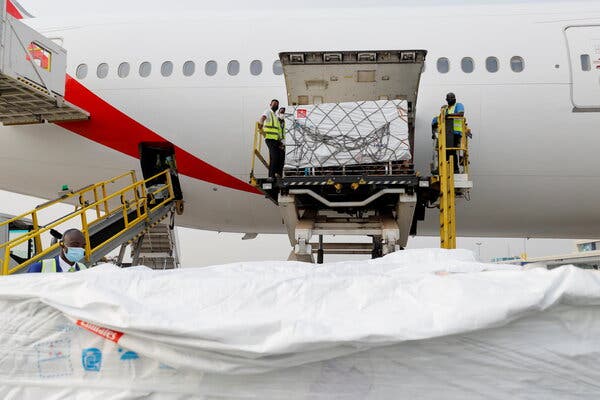
When 600,000 doses of the Oxford-AstraZeneca vaccine arrived in Ghana last week, Owusu Akoto, chief executive of a logistics company, was there alongside health officials to receive them.
Mr. Akoto’s company, FreezeLink, has a fleet of temperature-controlled trucks and was one of a few private companies helping the government to keep vaccines cooled before distribution. He is also partnering with a drone operator to reach some rural communities.
A former management consultant, Mr. Akoto founded his company in the hope of addressing food waste in Ghana, but he said that being involved in vaccine distribution had brought both pride and a sense of relief.
“It’s emotional. It feels a bit raw,” Mr. Akoto said in an interview from the Ghanaian capital, Accra. He said that his cousin had recently died after contracting the coronavirus. “The vaccine could have saved his life.”
The doses were the first delivery in a global initiative called Covax, created to ensure that poorer countries that would struggle to buy coronavirus shots on the open market could still receive them. Officials hope to deliver two billion vaccines worldwide through the initiative this year, though they say that the program faces a funding gap of billions of dollars.
By Thursday, about 10 million doses had been delivered to 11 countries in Africa through the Covax program, according to the World Health Organization.
Some vaccines, like those of Pfizer and Moderna, must be kept at deep-freeze temperatures for much of their time in storage and during delivery, a requirement that has long been a concern for distributors in areas with less infrastructure. But the AstraZeneca vaccine only needs to be stored at a temperature of 2 to 8 degrees Celsius, or about 35 to 46 degrees Fahrenheit, which makes it easier to handle by regular cold-storage companies.
Mr. Akoto said that a priority so far had been in areas with a surge in new infections. His company is also working with Zipline, a drone company, that is helping to deliver vaccines to more rural parts of Ghana that are harder to reach by road. Zipline said it was providing “on-demand, last-mile delivery” of the vaccine.
Mr. Akoto acknowledged that Ghana had a long way to go to inoculate the entire population of about 30 million, and he said he was concerned about vaccine skepticism.
“But the journey of a million miles just became that much shorter,” he said.
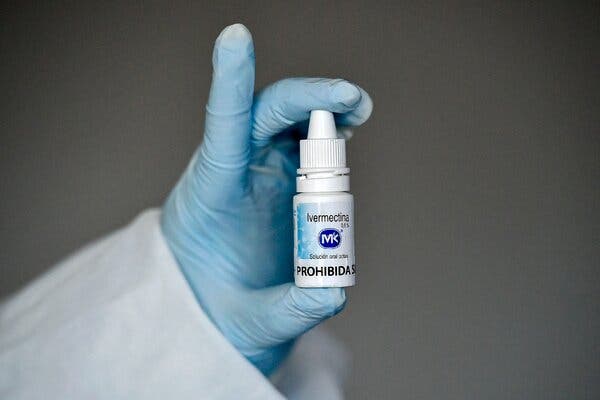
Ivermectin, an anti-parasitic drug that has been touted as a potential Covid-19 treatment, does not speed recovery in people with mild cases of the disease, according to a randomized controlled trial published in the journal JAMA today.
Ivermectin is typically used to treat parasitic worms in both people and animals. Scientists have previously reported that the drug can prevent some viruses from replicating in cells. Last year, researchers in Australia found that high doses of ivermectin suppressed SARS-CoV-2, the virus that causes Covid-19, in cell cultures.
The finding raised hopes that the drug might prove effective against Covid-19, and it has been widely used during the pandemic, especially in Latin America.
But rigorous data on the drug’s effectiveness in people has been lacking, and some scientists suspect that effectively inhibiting the coronavirus may require extremely high, potentially unsafe doses of the drug. The Covid-19 treatment guidelines from the National Institutes of Health note that there is not enough evidence “to recommend either for or against” using the drug in Covid-19 patients.
In the new study, a team of researchers in Colombia randomly assigned more than 400 people who had recently developed mild Covid-19 symptoms to receive a five-day course of either ivermectin or a placebo. They found that Covid-19 symptoms lasted about 10 days, on average, among people who received the drug, compared to 12 days among those who received the placebo, a statistically insignificant difference.
The new trial adds much-needed clinical data to the debate over using the drug to treat Covid-19, said Dr. Regina Rabinovich, a global health researcher at Harvard’s T.H. Chan School of Public Health, who was not involved in the study.
But she noted that the trial was relatively small and that it did not answer the most pressing clinical question, which is whether ivermectin can prevent severe disease or death. “Duration of symptoms may not be the most important either clinical or public health parameter to look at,” she said.
Bigger trials, some of which are currently underway, could help provide more definitive answers, said Dr. Rabinovich, who noted that she was “totally neutral” on ivermectin’s potential usefulness. “I just want data because there’s such chaos in the field.”



